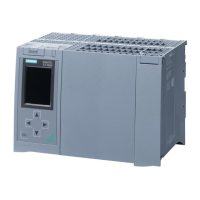PLC concepts
5.1 Execution of the user program
S7-1200 Programmable controller
110 System Manual, V4.2, 09/2016, A5E02486680-AK
Configuring the cycle time and communication load
You use the CPU properties in the Device configuration to configure the following
parameters:
● Cycle: You can enter a maximum scan cycle monitoring time. You can also enable and
enter a minimum scan cycle time.
● Communication load: You can configure a percentage of the time to be dedicated for
communication tasks.
For more information about the scan cycle, see "Monitoring the cycle time". (Page 109)
CPU memory
Memory management
The CPU provides the following memory areas to store the user program, data, and
configuration:
● Load memory is non-volatile storage for the user program, data and configuration. When
you download a project to the CPU, the CPU first stores the program in the Load memory
area. This area is located either in a memory card (if present) or in the CPU. The CPU
maintains this non-volatile memory area through a power loss. The memory card
supports a larger storage space than that built-in to the CPU.
● Work memory is volatile storage for some elements of the user project while executing
the user program. The CPU copies some elements of the project from load memory into
work memory. This volatile area is lost when power is removed, and is restored by the
CPU when power is restored.
● Retentive memory is non-volatile storage for a limited quantity of work memory values.
The CPU uses the retentive memory area to store the values of selected user memory
locations during power loss. When a power down or power loss occurs, the CPU restores
these retentive values upon power up.
To display the memory usage for a compiled program block, right-click the block in the
"Program blocks" folder in the STEP 7 project tree and select "Resources" from the context
menu. The Compiliation properties display the load memory and work memory for the
compiled block.
To display the memory usage for the online CPU, double-click "Online and diagnostics" in
STEP 7, expand "Diagnostics", and select "Memory".

